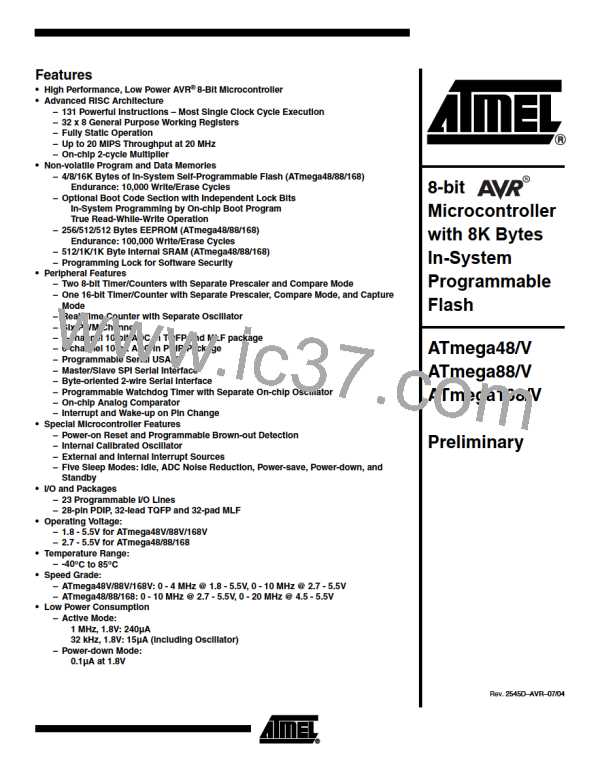ATmega48/88/168
Examples of Baud Rate
Setting
For standard crystal and resonator frequencies, the most commonly used baud rates for
asynchronous operation can be generated by using the UBRRn settings in Table 81.
UBRRn values which yield an actual baud rate differing less than 0.5ꢀ from the target
baud rate, are bold in the table. Higher error ratings are acceptable, but the Receiver will
have less noise resistance when the error ratings are high, especially for large serial
frames (see “Asynchronous Operational Range” on page 177). The error values are cal-
culated using the following equation:
BaudRateClosest Match
⎛
⎞
Error[%] = -------------------------------------------------- – 1 • 100%
⎝
⎠
BaudRate
Table 81. Examples of UBRRn Settings for Commonly Used Oscillator Frequencies
fosc = 1.0000 MHz fosc = 1.8432 MHz
U2Xn = 0 U2Xn = 1 U2Xn = 0 U2Xn = 1
fosc = 2.0000 MHz
U2Xn = 0 U2Xn = 1
Baud
Rate
(bps)
Error
0.2ꢀ
0.2ꢀ
-7.0ꢀ
8.5ꢀ
8.5ꢀ
8.5ꢀ
-18.6ꢀ
8.5ꢀ
–
Error
0.2ꢀ
0.2ꢀ
0.2ꢀ
-3.5ꢀ
-7.0ꢀ
8.5ꢀ
8.5ꢀ
8.5ꢀ
-18.6ꢀ
8.5ꢀ
–
Error
0.0ꢀ
0.0ꢀ
0.0ꢀ
0.0ꢀ
0.0ꢀ
0.0ꢀ
0.0ꢀ
0.0ꢀ
-25.0ꢀ
0.0ꢀ
–
Error
0.0ꢀ
0.0ꢀ
0.0ꢀ
0.0ꢀ
0.0ꢀ
0.0ꢀ
0.0ꢀ
0.0ꢀ
0.0ꢀ
0.0ꢀ
0.0ꢀ
–
Error
Error
UBRRn
UBRRn
UBRRn
UBRRn
UBRRn
UBRRn
2400
25
12
6
51
25
12
8
47
23
11
7
95
47
23
15
11
7
51
25
12
8
0.2ꢀ
0.2ꢀ
0.2ꢀ
-3.5ꢀ
-7.0ꢀ
8.5ꢀ
8.5ꢀ
8.5ꢀ
-18.6ꢀ
8.5ꢀ
–
103
51
25
16
12
8
0.2ꢀ
0.2ꢀ
0.2ꢀ
2.1ꢀ
0.2ꢀ
-3.5ꢀ
-7.0ꢀ
8.5ꢀ
8.5ꢀ
8.5ꢀ
–
4800
9600
14.4k
19.2k
28.8k
38.4k
57.6k
76.8k
115.2k
230.4k
250k
3
2
6
5
6
1
3
3
3
1
2
2
5
2
6
0
1
1
3
1
3
–
1
1
2
1
2
–
–
0
0
1
0
1
–
–
–
–
0
–
–
–
–
–
–
–
–
–
–
–
0
0.0ꢀ
Max.(1)
62.5 kbps
125 kbps
115.2 kbps
230.4 kbps
125 kbps
250 kbps
Note:
1. UBRRn = 0, Error = 0.0ꢀ
185
2545D–AVR–07/04

 ATMEL [ ATMEL ]
ATMEL [ ATMEL ]